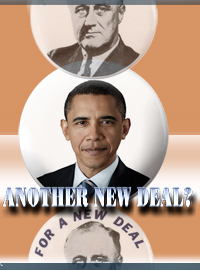
|
Those looking for a villain for the 1930s downturn should look to three factors: inflation, excessive regulation and the distortionary power of unions who earned special legislative favors from Washington. Food for thought for those looking for parallels to the present day.
|
|
| If modern liberalism triumphs among the professoriate, it may be because the left shares an instinctive bias with the academy: to lecture is better than to learn. And who better to embody this ethos than the nation’s professor-in-chief, Barack Obama, for whom obtrusiveness is next to godliness?
Holding court in Toronto last weekend at the G-20 summit, Obama launched into a Keynesian jeremiad, warning that a reduction in government spending in the world’s leading economies could bring seizing fits upon global recovery. Not that the world’s assembled leaders were waiting with baited breath to learn the ingredients of Obama’s market elixir.
When your best argument is “So people kind of say, yeah, but unemployment is still at 9.6. Yes, but it’s not 12 or 13, or 15,” you shouldn’t expect to be treated as an economic oracle. Keeping in mind that Obama’s Recovery Act promised unemployment of no more than 8 percent, the heads of government assembled in Canada studiously ignored the browbeating.
But if the various potentates of the developed world weren’t willing to serve as the president’s bucket brigade, he can always count on his enablers in the media. With Senate Republicans blocking Obama’s more than $100 billion push for extending unemployment benefits and sending aid to states – on the utterly sensible grounds that congressional Democrats should find a way to pay for it – the beltway media has discovered its inner Cassandra.
The pundits are increasingly warning that a bout of spending restraint will generate negative results similar to those that accompanied Franklin Roosevelt’s push to reign in federal excess during the second term of his presidency. The bout of handwringing has been bicoastal.
In the New York Times, David Leonhart writes, “The parallels to 1937 are not reassuring. From 1933 to 1937, the United States economy expanded more than 40 percent, even surpassing its 1929 high. But the recovery was still not durable enough to survive Roosevelt’s spending cuts and new Social Security tax. In 1938, the economy shrank 3.4 percent, and unemployment spiked.”
Three thousand miles away, the Los Angeles Times’ Michael Hiltzik – who writes in the newspaper the way that most men pace in a maternity ward waiting room – frets, “... Franklin D. Roosevelt bowed to his era's deficit hawks and cut back on federal programs to bring the federal budget more into balance. He got the recession of 1937 for his pains.”
There are two lessons here, neither grasped by Leonhart or Hiltzik. The first is that columnists, like surgeons, should not attempt to improvise expertise.
The second – an axiom of logic – is that because one event follows another, it cannot reliably be concluded that the first event caused the second.
The cause of FDR’s depression within the depression wasn’t spending restraint. Herbert Hoover ran substantial deficits from 1929 to 1932 without generating a recovery. Similarly, deficit spending dropped sharply after World War II without endangering the prospects for growth. In fact, total federal spending was actually lower in 1935 – considered a year of recovery – than it was in the down years of 1936 and 1937. And in 1937, government spending was higher than in all years prior to 1936 … not exactly an example of austerity.
Those looking for a villain for the 1930s downturn should look to three factors: inflation, excessive regulation and the distortionary power of unions who earned special legislative favors from Washington. Food for thought for those looking for parallels to the present day. |

























